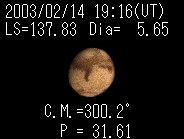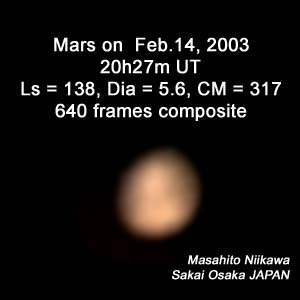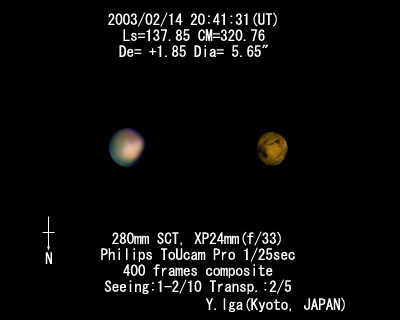火星 月惑星研究会 関西支部 (最新)
ALPO-Japan Latest
Mars Image 2003/02/14(UT)
池村俊彦,新川勝仁,伊賀祐一,Mars Global Surveyor
T.Ikemura,M.Niikawa,Y.Iga,MGS
解説(安達)
日本の観測が3枚も集まったのは、今シーズン初めてのことだ。
シルチス(Syrtis major;290W,+10)がかろうじて分かる程度で、情
報が得にくいが、新川氏の画像でヘラス(Hellas;300W0-50)がやや
白っぽくなっているのが気になる。
Three observers in Japan were gathered is the first time.
Either of the seeing are bad and Syrtis major8290W,+10) can
be just seen. In Niikawa's image, that the Hellas is
deteriorated in whitish becomes feeling.
FROM Makoto ADACHI
-------------------------------------------------------------------------------------
|
Toshihiko Ikemura (310mm Newton, Digital still camera NEC PICONA)
|
|
 Simulated by Ikemura
Simulated by Ikemura

This is my first image of this apparition. seeing: 2/5 Altitude: about 15 degs
私の初観測です。地平高度 約15゜と思われる。
やっと丸いことがわかる程度で、眼視では模様は何もみえなかった。
≪愛知県名古屋市 池村俊彦≫
|
Masahito Niikawa (280mm SC, Sony DCR-TRV110)
|
|

Mars on Feb.14, 2003 20h27m UT
Ls = 138, Dia = 5.6, CM = 317
Sony DCR-TRV110
Effective Fno. = 25
Composite of R60 images(NightShot Mode) and RGB images
Exposure = 0.03 sec
640 frames composite
Seeing = 1/10, Transparency = 2/6
Observer:Masahito Niikawa Sakai Osaka JAPAN
Pricessed with Registax and Photoshop
かろうじて、ヘラスと大シルチスが認められる。
-----------------------------------------------------
風もなく、シーイングは良さそうだったのですが、
実際には、ぼろぼろでした。
ビデオの画像も激しく踊っていました。
例によって、ビデオとRegistaxの組み合わせです。
しかし、1日がかりで処理をしてこの程度とは、
少し情けないです。
≪大阪府 堺市 新川勝仁≫
|
Yuichi Iga (280mm SC, Philips ToUcam Pro)
|
|

2003/02/14UTの火星観測です。
-------------------------------------
2003/02/14 20:41:31(UT)
Ls=137.85 CM=320.76
De= +1.85 Dia= 5.65"
280mm SCT, XP24mm(f/33)
Philips ToUcam Pro 1/25sec
400 frames composite
Seeing:1-2/10 Transp.:2/5
-------------------------------------
コメント:
・何とか模様が撮影できましたが、かなり無理をした画像処理です。
・シルチスとヘラスは明らかに確認できます。
・サバエウス辺りは不確かですね。
・今回はIRカットを入れていないので、不十分だと思っていますが、
次回からはきちんとIRカットを入れて撮影します。
≪京都市山科区 伊賀 祐一≫
|
Mars Global Surveyor (daily global imaging campaign)
|
|

The Mars Global Surveyor (MGS) Mars Orbiter Camera (MOC) began its daily global imaging campaign four years ago, on March 9, 1999. Since that time, slightly more than 2 full Martian years have elapsed, and MOC has obtained a complete daily record of the red planet's ever-changing weather patterns. Observing Mars every day over many years is critical to understanding how to forecast weather that may occur in the future, and MOC is the only U.S. instrument slated to orbit Mars until late 2006 that can provide this information. For example, the MOC team has found that many weather events repeat from one year to the next. Such knowledge is useful in considering where future spacecraft might land on Mars---a site that is known to experience a dust storm each year during the period a lander or rover will be operational might not be a good place to land.
The six views of Mars shown here are a composite of the 24 daily global images acquired by MOC on February 14, 2003. At this time, it was the middle of summer in the northern hemisphere, and the middle of winter in the south. Taken together, the six views show the entire planet, its albedo (bright and dark) features, polar frosts, and cloud patterns. Water-ice clouds dominate the martian atmosphere over the tropical and sub-tropical latitudes, while orographically-generated (i.e. those associated with high-standing topography) water-ice clouds hang over each of the large volcanoes of the Tharsis and Elysium regions (see top-left, top-center, bottom-right).
In the north polar region, the residual water-ice cap is fully exposed. In the southern hemisphere, the winter-time seasonal carbon dioxide frost cap can be seen, extending from the south pole (which is in darkness and not seen in these images) northward to 50°S latitude. In the deep Hellas Basin (an ancient, giant impact scar seen as the bright elliptical feature at the bottom of the bottom-center image), the winter-time cap extends northward to 31°S because the lower elevation permits carbon dioxide to freeze at slightly higher temperatures than at the high elevations elsewhere in the southern hemisphere.
When these pictures were taken on February 14, 2003, dust storm activity was at a minimum and isolated to early morning hours around the edges of the north polar cap. Within a day, however, dust storm activity began to pick up in both hemispheres--as was expected from previous MOC images at this time of year in 1999 and 2001--and dust storms remained active through the rest of February and March.
CM= 0 CM= 60
CM= 60 CM=120
CM=120 CM=180
CM=180 CM=240
CM=240 CM=300
CM=300
TIFF 4.5MB
≪Mars Global Surveyor NASA≫
 ALPO-Japan Latest
ALPO-Japan Latest

 Mars Section
Mars Section
 ALPO-Japan Latest
ALPO-Japan Latest

 Mars Section
Mars Section
 Simulated by Ikemura
Simulated by Ikemura



 CM= 60
CM= 60 CM=120
CM=120 CM=180
CM=180 CM=240
CM=240 CM=300
CM=300 ALPO-Japan Latest
ALPO-Japan Latest

 Mars Section
Mars Section